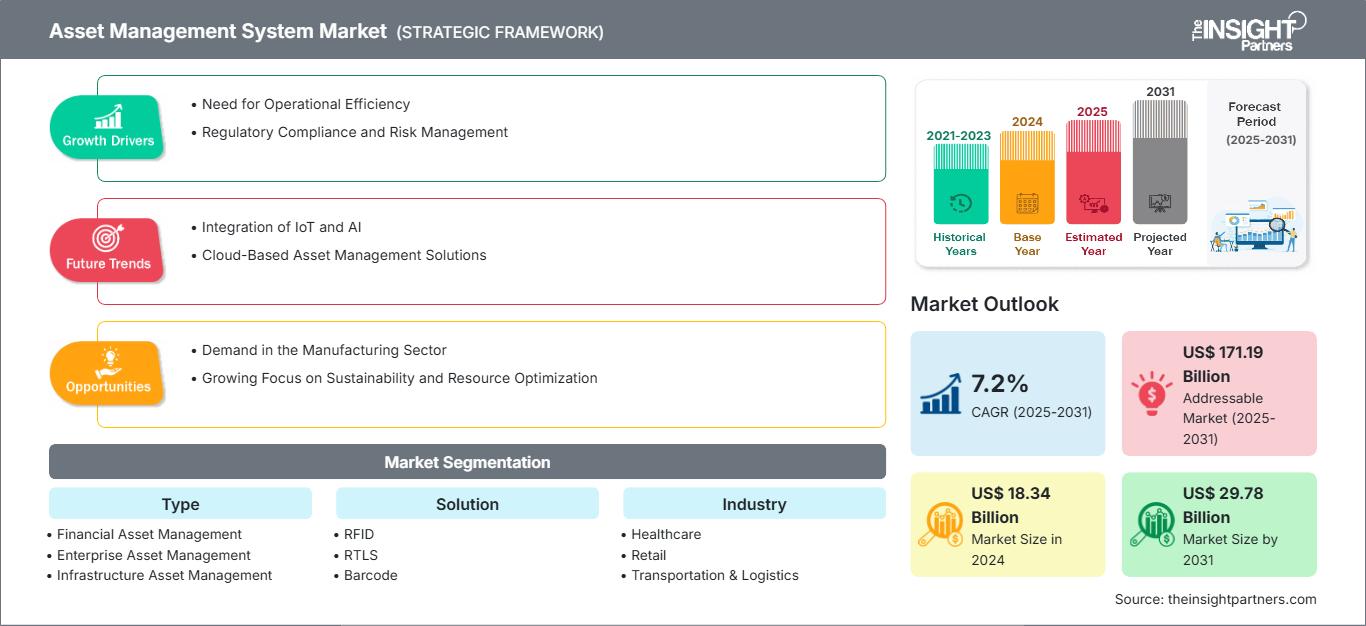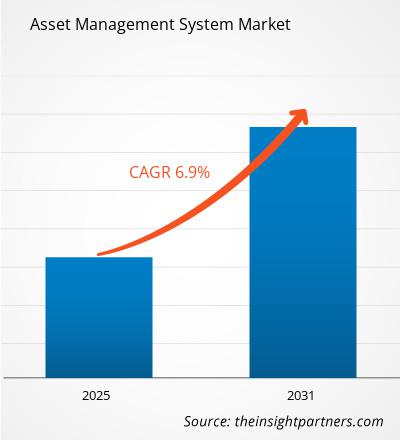Der Markt für Asset-Management-Systeme soll von 18,34 Milliarden US-Dollar im Jahr 2024 auf 29,78 Milliarden US-Dollar im Jahr 2031 anwachsen; im Prognosezeitraum wird eine durchschnittliche jährliche Wachstumsrate (CAGR) von 7,2 % erwartet.
Der Bericht ist nach Typ (Finanzanlagenverwaltung, Unternehmensanlagenverwaltung, Infrastrukturanlagenverwaltung, öffentliche Anlagenverwaltung, IT-Anlagenverwaltung, Anlageanlagenverwaltung und digitale Anlagenverwaltung), Lösung (RFID, RTLS, Barcode, GPS und andere) und Branche (Gesundheitswesen, Einzelhandel, Transport und Logistik, Öl und Gas, Bergbau und andere) segmentiert. Die globale Analyse ist weiter nach regionalen und wichtigsten Ländern aufgeschlüsselt. Der Bericht bietet den Wert in USD für die obige Analyse und Segmente.
Zweck des Berichts
Der Bericht „Asset-Management-System-Markt“ von The Insight Partners soll die aktuelle Situation und das zukünftige Wachstum sowie die wichtigsten treibenden Faktoren, Herausforderungen und Chancen beschreiben. Dies bietet verschiedenen Geschäftspartnern Einblicke, wie beispielsweise:
- Technologieanbieter/-hersteller: Um die sich entwickelnde Marktdynamik zu verstehen und die potenziellen Wachstumschancen zu kennen, damit sie fundierte strategische Entscheidungen treffen können.
- Investoren: Um eine umfassende Trendanalyse hinsichtlich der Marktwachstumsrate, der finanziellen Marktprognosen und der Chancen entlang der Wertschöpfungskette durchzuführen.
- Regulierungsbehörden: Um Richtlinien und Überwachungsaktivitäten auf dem Markt zu regulieren, mit dem Ziel, Missbrauch zu minimieren, das Vertrauen der Investoren zu wahren und die Integrität und Stabilität des Marktes aufrechtzuerhalten.
Marktsegmentierungstyp für Asset-Management-Systeme
- Finanzielles Asset-Management
- Enterprise Asset Management
- Infrastruktur-Asset-Management
- Öffentliches Asset-Management
- IT-Asset-Management
- Anlagen-Asset-Management und digitales Asset-Management
Lösung
- RFID
- RTLS
- Barcode
- GPS und andere
Branche
- Gesundheitswesen
- Einzelhandel
- Transport und Logistik
- Öl und Gas
- Bergbau und andere
Geografie
- Nordamerika
- Europa
- Asien-Pazifik
- Süd- und Mittelamerika
- Naher Osten und Afrika
Sie erhalten kostenlos Anpassungen an jedem Bericht, einschließlich Teilen dieses Berichts oder einer Analyse auf Länderebene, eines Excel-Datenpakets sowie tolle Angebote und Rabatte für Start-ups und Universitäten.
Markt für Asset-Management-Systeme: Strategische Einblicke

- Holen Sie sich die wichtigsten Markttrends aus diesem Bericht.Dieses KOSTENLOSE Beispiel umfasst Datenanalysen, die von Markttrends bis hin zu Schätzungen und Prognosen reichen.
Wachstumstreiber für Asset-Management-Systeme
- Bedarf an betrieblicher Effizienz: Unternehmen aller Branchen konzentrieren sich auf die Verbesserung der betrieblichen Effizienz, um Kosten zu senken und die Produktivität zu maximieren. Asset-Management-Systeme spielen dabei eine entscheidende Rolle, da sie Echtzeit-Einblicke in die Anlagennutzung, Wartungspläne und das Lebenszyklusmanagement bieten. Dies hilft Unternehmen, die Anlagenleistung zu optimieren, Ausfallzeiten zu reduzieren und die Ressourcenzuweisung zu verbessern, was das Marktwachstum vorantreibt.
- Einhaltung gesetzlicher Vorschriften und Risikomanagement: Immer strengere Vorschriften und der Bedarf an Risikomanagement sind die Haupttreiber des Marktes für Asset-Management-Systeme. Unternehmen müssen sicherstellen, dass ihre Anlagen den Branchenstandards und -vorschriften entsprechen. Asset-Management-Systeme helfen bei der Verfolgung, Überwachung und Einhaltung von Wartungs-, Sicherheits- und Betriebsstandards und reduzieren so das Risiko von Nichteinhaltung und möglichen Strafen.
Zukünftige Trends im Markt für Asset-Management-Systeme
- Integration von IoT und KI: Die Integration von Technologien des Internets der Dinge (IoT) und künstlicher Intelligenz (KI) in Asset-Management-Systeme ist ein wichtiger Trend. IoT ermöglicht die Echtzeitverfolgung von Assets, während KI erweiterte Analysen und vorausschauende Wartung bietet und so die Entscheidungsfindung verbessert. Zusammen ermöglichen sie es Unternehmen, Anlagenausfälle vorherzusagen, die Nutzung zu optimieren und Ausfallzeiten zu reduzieren, was den Mehrwert von Asset-Management-Systemen steigert.
- Cloudbasierte Asset-Management-Lösungen: Cloudbasierte Asset-Management-Lösungen erfreuen sich zunehmender Beliebtheit, da Unternehmen nach flexibleren, skalierbaren und kostengünstigeren Lösungen suchen. Cloud-Plattformen ermöglichen einfacheren Zugriff, Datenaustausch in Echtzeit und eine nahtlose Integration mit anderen Unternehmensystemen. Dieser Trend ist besonders vorteilhaft für Unternehmen mit mehreren Standorten oder solche, die eine zentrale Kontrolle über das Asset Management verschiedener Betriebsabläufe anstreben.
Marktchancen für Asset-Management-Systeme
- Nachfrage im Fertigungssektor: Die Fertigungsindustrie bietet erhebliches Wachstumspotenzial für den Markt für Asset-Management-Systeme. Mit komplexen Maschinen, Anlagen und Produktionslinien benötigen Hersteller fortschrittliche Systeme zur Verwaltung und Instandhaltung ihrer Anlagen. Durch die Integration von Asset-Management-Systemen können Hersteller die Anlagenleistung optimieren, Betriebskosten senken und kostspielige Ausfälle vermeiden – eine lukrative Geschäftsmöglichkeit.
- Wachsender Fokus auf Nachhaltigkeit und Ressourcenoptimierung: Mit der zunehmenden Betonung der Nachhaltigkeit versuchen Unternehmen, die Anlagennutzung zu optimieren und Abfall zu reduzieren. Asset-Management-Systeme ermöglichen eine bessere Nachverfolgung, Planung und Wartung, was zu längeren Anlagenlebenszyklen und geringeren Umweltauswirkungen führt. Dies stellt eine große Chance dar, da Unternehmen nachhaltige Praktiken und die Einhaltung von Umweltvorschriften anstreben.
Regionale Einblicke in den Markt für Asset-Management-Systeme
Die Analysten von The Insight Partners haben die regionalen Trends und Faktoren, die den Markt für Asset-Management-Systeme im Prognosezeitraum beeinflussen, ausführlich erläutert. In diesem Abschnitt werden auch die Marktsegmente und die geografische Lage in Nordamerika, Europa, dem asiatisch-pazifischen Raum, dem Nahen Osten und Afrika sowie Süd- und Mittelamerika erörtert.
Umfang des Marktberichts zum Asset-Management-System
| Berichtsattribut | Einzelheiten |
|---|---|
| Marktgröße in 2024 | US$ 18.34 Billion |
| Marktgröße nach 2031 | US$ 29.78 Billion |
| Globale CAGR (2025 - 2031) | 7.2% |
| Historische Daten | 2021-2023 |
| Prognosezeitraum | 2025-2031 |
| Abgedeckte Segmente |
By Typ
|
| Abgedeckte Regionen und Länder | Nordamerika
|
| Marktführer und wichtige Unternehmensprofile |
|
Dichte der Marktteilnehmer für Asset-Management-Systeme: Verständnis ihrer Auswirkungen auf die Geschäftsdynamik
Der Markt für Asset-Management-Systeme wächst rasant. Dies wird durch die steigende Nachfrage der Endnutzer aufgrund veränderter Verbraucherpräferenzen, technologischer Fortschritte und eines stärkeren Bewusstseins für die Produktvorteile vorangetrieben. Mit der steigenden Nachfrage erweitern Unternehmen ihr Angebot, entwickeln Innovationen, um den Bedürfnissen der Verbraucher gerecht zu werden, und nutzen neue Trends, was das Marktwachstum weiter ankurbelt.

- Holen Sie sich die Markt für Asset-Management-Systeme Übersicht der wichtigsten Akteure
Wichtige Verkaufsargumente
- Umfassende Abdeckung: Der Bericht analysiert umfassend Produkte, Dienstleistungen, Typen und Endnutzer des Marktes für Asset-Management-Systeme und bietet einen ganzheitlichen Überblick.
- Expertenanalyse: Der Bericht basiert auf dem umfassenden Verständnis von Branchenexperten und Analysten.
- Aktuelle Informationen: Der Bericht gewährleistet Geschäftsrelevanz durch die Berichterstattung über aktuelle Informationen und Datentrends.
- Anpassungsoptionen: Dieser Bericht kann an spezifische Kundenanforderungen angepasst werden und passt sich so optimal an die Geschäftsstrategien an.
Der Forschungsbericht zum Markt für Asset-Management-Systeme kann daher dazu beitragen, die Branchensituation und die Wachstumsaussichten zu entschlüsseln und zu verstehen. Obwohl es einige berechtigte Bedenken geben kann, überwiegen die Vorteile dieses Berichts tendenziell die Nachteile.
- Historische Analyse (2 Jahre), Basisjahr, Prognose (7 Jahre) mit CAGR
- PEST- und SWOT-Analyse
- Marktgröße Wert/Volumen – Global, Regional, Land
- Branchen- und Wettbewerbslandschaft
- Excel-Datensatz
Aktuelle Berichte
Verwandte Berichte
Erfahrungsberichte
Grund zum Kauf
- Fundierte Entscheidungsfindung
- Marktdynamik verstehen
- Wettbewerbsanalyse
- Kundeneinblicke
- Marktprognosen
- Risikominimierung
- Strategische Planung
- Investitionsbegründung
- Identifizierung neuer Märkte
- Verbesserung von Marketingstrategien
- Steigerung der Betriebseffizienz
- Anpassung an regulatorische Trends




















 Kostenlose Probe anfordern für - Markt für Asset-Management-Systeme
Kostenlose Probe anfordern für - Markt für Asset-Management-Systeme